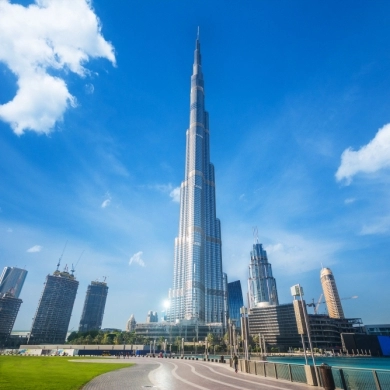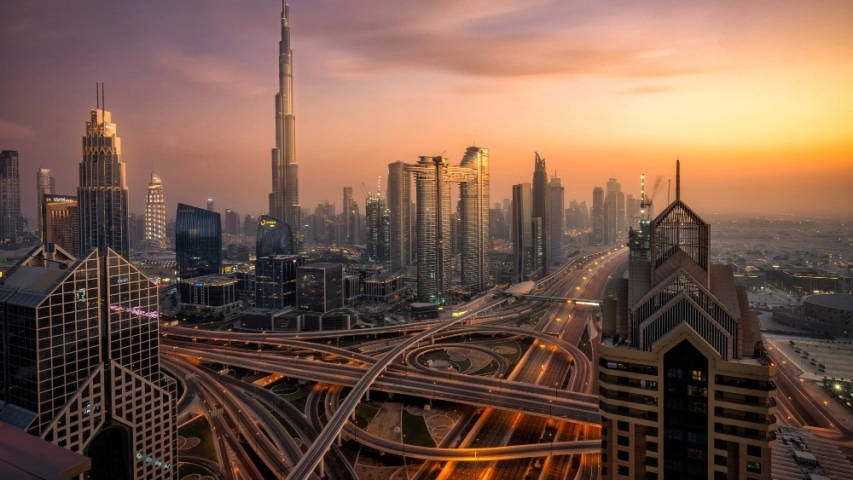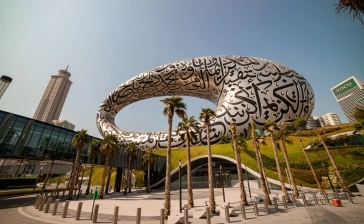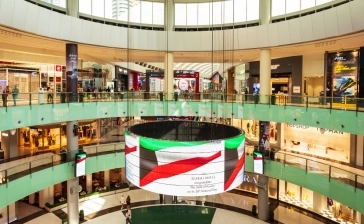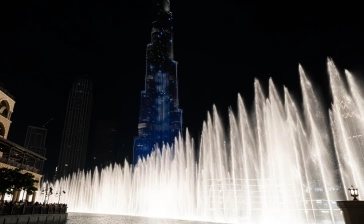The city of Dubai is known worldwide for its incredible growth, imposing skyscrapers, and luxurious hotels. Although tourism in Dubai can be a unique experience, it is essential to address how this city is experienced from the perspective of a person in a wheelchair. In these lines, we will introduce you to the history of Dubai, give you some interesting facts, and discover curiosities and opportunities that this metropolis offers to its visitors with reduced mobility. Dubai's history dates back more than 4,000 years, with archaeological evidence of settlements in the area dating from the Bronze Age. However, modern Dubai began to take shape in the 19th century when the Bani Yas tribe, led by the Al Maktoum family, settled in the area. Since then, Dubai has become an important trading and pearl center in the region. The real turning point in Dubai's history was the discovery of oil in 1966. This finding brought enormous wealth to the city and allowed Sheikh Rashid bin Saeed Al Maktoum, then ruler of Dubai, to invest in infrastructure and urban development projects. In 1971, Dubai joined six other emirates to form the United Arab Emirates. Since then, Dubai has experienced unprecedented growth, becoming an ultra-modern metropolis known for its innovative architecture, luxury, and tourism. Despite the wealth generated by oil, Dubai has worked to diversify its economy, focusing on sectors such as trade, transportation, tourism, and finance.
Interesting facts:
- Population and diversity: Dubai is the most populous emirate of the United Arab Emirates, with approximately 3.4 million inhabitants. What is even more surprising is that over 80% of Dubai's population is made up of expatriates, making it one of the most multicultural cities in the world.
- Skyscrapers and architecture: Dubai is home to over 200 skyscrapers, including the Burj Khalifa, the world's tallest building at 828 meters high. In addition, the city features unique architectural projects, such as the Palm Jumeirah Islands, the palm-shaped artificial archipelago, and the Burj Al Arab Hotel, known as the world's only 7-star hotel.
- Economy: Although oil was crucial in Dubai's initial development, it currently accounts for less than 1% of its GDP. The city's economy has successfully diversified, and tourism is one of the main economic drivers. Dubai receives over 16 million tourists per year, and this number is expected to continue increasing.
- Sustainability: Despite its image of luxury and excess, Dubai has begun to address issues of sustainability and the environment. The city has launched initiatives such as the "Dubai Clean Energy Strategy 2050", with the aim of obtaining 75% of its energy from clean sources by 2050. In addition, sustainable transport projects are being developed, such as the driverless metro system and the Hyperloop.
Curiosities and accessibility:
- The city of gold: Dubai is known as the "city of gold" due to the large number of gold shops found in its souks and shopping centers. In fact, Dubai's Gold Souk is one of the largest gold markets in the world. These souls and shopping centers are usually accessible for people in wheelchairs, with ramps and elevators available.
- The busiest airport in the world: Dubai International Airport is the busiest in the world in terms of international passengers. This airport is highly accessible for wheelchair users, with appropriate facilities and services, such as adapted bathrooms and free wheelchairs.
- Accessible beaches: Dubai has several public and private beaches with accessible facilities for people in wheelchairs. These include ramps, amphibious chairs, and shaded areas. An example of this is Al Mamzar beach, which offers an inclusive and pleasant environment for all visitors.
In summary, Dubai is a city that has experienced astonishing growth and development in recent decades. From its origins as a small settlement to becoming an ultra-modern metropolis, Dubai has managed to position itself as a top-tier tourist destination. Although accessibility remains a challenge in some areas of the city, significant efforts have been made to improve the experience for people in wheelchairs. With a combination of impressive architecture, exciting tourist attractions, and diverse culture, Dubai offers a unique and unforgettable experience for all its visitors, including those with reduced mobility.
Accessible tourism offices in Dubai play a crucial role in providing information and resources to visitors with reduced mobility or disabilities. Below is information on the most important ones:
Dubai Tourism (Department of Tourism and Commerce Marketing, DTCM):
The main tourism office of Dubai is located in the Al Fattan Plaza building, in the Al Garhoud area. The building has wheelchair access, ramps, and elevators, making entry and movement within the office easy. The DTCM provides information on accessible tourist attractions, accommodation, and transportation in the city.
Address and contact:
- Al Fattan Plaza Building, Airport Road, Al Garhoud, Dubai, United Arab Emirates
- Phone: (+971) 600 55 5559
- Web: https://www.visitdubai.com
At the Top Visitor Center, Burj Khalifa:
This visitor center is located in the iconic Burj Khalifa and offers information about the tower and its surroundings. Access to the facilities is completely wheelchair accessible, with ramps and elevators available.
Address and contact:
- At the Top, Burj Khalifa, Dubai Mall, Lower Ground Level, Downtown Dubai, Dubai, United Arab Emirates
- Phone: (+971) 4 366 1655
- Web: https://www.atthetop.ae
Tourist Information Kiosks in Dubai Mall and Mall of the Emirates:
These tourist information kiosks are located in two of the largest and most popular shopping malls in Dubai. Both shopping malls have wheelchair access, ramps, elevators, and adapted restrooms.
The tourist information kiosks in Dubai Mall and Mall of the Emirates provide useful information to visitors about attractions and activities in Dubai. Here are the addresses and contact information for each of them:
Dubai Mall:
Address and contact:
- Dubai Mall, Financial Centre Road, Downtown Dubai, Dubai, United Arab Emirates
- Phone: (+971) 800 382246255 (800-DUBAI-MALL)
- Web: https://thedubaimall.com
Mall of the Emirates:
Address and contact:
- Mall of the Emirates, Sheikh Zayed Road, Al Barsha 1, Dubai, United Arab Emirates
- Phone: (+971) 4 409 9000
- Web: https://www.malloftheemirates.com
Dubai Cruise Terminal:
Located in Port Rashid, the Dubai Cruise Terminal is the arrival point for international cruises visiting the city. The terminal has accessible facilities for wheelchair users, including adapted restrooms and rest areas. The tourist information center staff can provide information about accessible tourist attractions and transportation in the city.
Address and contact:
- Dubai Cruise Terminal, Port Rashid, Dubai, United Arab Emirates
- Phone: (+971) 4 313 9999 (Dubai Ports and Customs Authority)
- Web: https://www.dpworld.ae (DP World's website, which operates Port Rashid)
It is important to mention that, in addition to physical tourism offices, online resources and guides on accessibility in Dubai can also be found. Some websites and mobile apps provide detailed information about accessible tourist attractions, accommodations, restaurants, and transportation in the city. These online resources can be of great help in planning and enjoying an accessible experience in Dubai.
The NOL Card:
The Nol Card is a rechargeable electronic card used in Dubai's public transportation system, including the metro, tram, buses, and water taxis (abra). The card was introduced by Dubai's Roads and Transport Authority (RTA) to facilitate access to and payment for public transportation services in the city.
The Nol Card works with a contactless payment system, which means you simply need to tap the card to the reader at the metro station, bus stop, tram terminal, or at the entrance of water taxis when boarding and disembarking the transport for the trip cost to be automatically deducted.
There are four types of Nol Cards:
- Nol Red Ticket: This is a rechargeable paper ticket designed for occasional travelers and tourists. You can load up to 10 metro and tram trips or 5 bus trips. It is not valid for taxi rides.
- Nol Silver Card: This is a rechargeable plastic card that can be used on all modes of public transportation. It is suitable for residents and frequent travelers. The card has a maximum balance of 1000 AED.
- Nol Gold Card: Similar to the Nol Silver Card, but with access to the Gold Class (first-class) on the metro and tram. The fare for traveling in Gold Class is more expensive than in regular class. The card has a maximum balance of 1000 AED.
- Nol Blue Card: This is a personalized and rechargeable card with additional features such as protected balance in case of loss or theft, and the automatic top-up option. It is suitable for residents who regularly use public transportation. The card has a maximum balance of 5000 AED.
You can purchase and top-up Nol Cards at metro stations, selected bus stops, ticket vending machines, RTA sales offices, and some supermarkets. You can also check and recharge the card balance online through the RTA website or by using the RTA Dubai app.
Using the Nol Card is a convenient and cost-effective way to travel around Dubai, as it allows for easy and quick access to different modes of public transportation in the city.
Airport:
Dubai International Airport (DXB) is one of the largest and most modern airports in the world and offers a wide range of services and amenities for wheelchair users and passengers with reduced mobility.
Here is some information about accessibility and services available at Dubai Airport for wheelchair users:
- Special assistance: Dubai Airport offers special assistance for passengers with reduced mobility, including wheelchair transport, electric buggy transport, and accompaniment by trained staff. To access these services, it is important that you contact your airline before your flight (usually at least 48 hours in advance) and request special assistance.
- Airport accessibility: Dubai Airport is designed to be wheelchair-accessible, with ramps, elevators, adapted restrooms, and low information and check-in counters. Boarding gates are also equipped with accessible boarding bridges to facilitate access to airplanes.
- Adapted restrooms: You will find wheelchair-accessible restrooms throughout the airport, featuring additional space, grab bars, and accessible sinks.
- Special waiting rooms: Some terminals at Dubai Airport have special waiting rooms for people with disabilities, offering a comfortable and quiet space to rest before the flight.
- Wheelchair service: If you need a wheelchair at the airport, contact your airline before your flight to request this service. Some airlines also allow you to bring your own wheelchair.
- Accessible parking: Dubai Airport offers accessible parking spaces for people with disabilities near the entrances of the terminals.
- Trained staff: Dubai Airport staff are trained to assist people with disabilities and reduced mobility.
To ensure that you receive the appropriate assistance and have a comfortable and trouble-free experience at Dubai Airport, it is essential that you contact your airline before your trip and request the necessary services and adaptations.
Transportation from the airport to the city center:
To get from Dubai International Airport (DXB) to the city center by public transportation and wheelchair, you can use several methods; we explain the most common and accessible ones.
Dubai Metro:
The metro is accessible for people with reduced mobility, as it has elevators, ramps, and special carriages for wheelchairs. Here are the steps to get to the city center from the airport:
- Head to the airport metro station: Dubai International Airport has two metro stations located in Terminals 1 and 3. If you arrive at Terminal 2, you can take a free internal bus that will take you to Terminal 1 or Terminal 3.
- Purchase a single ticket or Nol Card: At the metro station, buy a single-trip ticket or a rechargeable Nol Card. The Nol Card is an electronic card that can be used on the metro, tram, buses, and water taxis in Dubai. Make sure it has enough balance to cover the trip to the city center.
- Take the red metro line: Both airport metro stations (Terminal 1 and Terminal 3) are on the red metro line. Board the train in the direction of "UAE Exchange" and disembark at the station closest to your destination in the city center. Some popular stations in the city center include "BurJuman", "Union", and "Al Rigga".
- Change lines, if necessary: If your final destination is on the green metro line, you will need to transfer at an interchange station like "Union" or "BurJuman". Upon arriving at the interchange station, follow the signs to change to the green line and board the train in the direction of "Etisalat" or "Creek", depending on your destination.
Please note that the Dubai Metro operates from 5:00 a.m. to midnight from Saturday to Wednesday, from 5:00 a.m. to 1:00 a.m. on Thursdays, and from 10: 00 a.m. to 1:00 a.m. on Fridays. Make sure to plan your trip according to these schedules.
Bus:
Traveling by bus from Dubai International Airport to the city center is also possible and wheelchair accessible, as most buses in Dubai are equipped with ramps and designated wheelchair spaces. However, keep in mind that traveling by bus can take longer compared to the metro. Here's how to get to the city center by bus:
- Find the bus stop: There are bus stops at all three airport terminals. In Terminal 1 and Terminal 3, the stops are located on the ground floor, at the terminal exit. In Terminal 2, the bus stop is located in front of the terminal.
- Purchase a ticket or Nol card: If you don't already have a Nol card, you can buy one at the vending machines or ticket sales counters located in the terminals. Make sure you have enough balance to cover the bus fare.
- Take the appropriate bus: Depending on your destination in the city center, you may need to take a specific bus. Some of the bus routes departing from the airport and heading to the city center are:
- Bus C1: from Terminal 1 and Terminal 3 to Al Satwa Bus Station, passing through Deira City Centre and BurJuman.
- Bus 27: from Terminal 2 to Gold Souq Bus Station, passing through Al Rigga and Baniyas Square, which are the largest and most well-known stations in the city.
You can plan your bus route using mapping apps like Google Maps or the official Dubai public transport app, RTA Dubai, available for iOS and Android. These apps will help you find the fastest and most convenient route, as well as bus schedules.
Taxi:
Taking a taxi from Dubai International Airport to the city center is a convenient and accessible option for wheelchair users. There are wheelchair-adapted taxis available at the airport, known as "special taxis." These taxis have access ramps and enough space to accommodate a wheelchair. Follow these steps to take an adapted taxi from the airport:
- Head to the taxi stand: Taxi stands are located in the arrivals areas of all three terminals. Look for signs indicating the location of wheelchair-accessible special taxis.
- Request a special taxi: If you don't see any adapted taxis at the taxi stand, ask airport staff to help you request one. You can also call the RTA (Roads and Transport Authority) at +971 4 208 0808 to request a special taxi.
- Pay the fare: Upon arriving at your destination, pay the taxi fare using cash, credit card, or a Nol card if the taxi is equipped with a Nol card reader.
Note that taxis in Dubai charge a minimum fare from the airport, in addition to a per-kilometer and waiting time fee. Taxis in Dubai are a comfortable and fast option for getting to the city center, especially if you have additional luggage or prefer private transportation. However, the cost will be higher compared to the metro or bus.
Transportation within the city:
Public transportation in Dubai is designed to be accessible for people with reduced mobility, including wheelchair users. Here I detail the accessible public transportation options in Dubai:
Dubai Metro:
The Dubai Metro has accessible facilities at all stations, including elevators, ramps, and Braille signage. The trains have special cars designated for people with disabilities and wheelchairs, identified by a symbol on the car doors. There are also reserved spaces inside the car to accommodate wheelchair users.
Dubai Tram:
The Dubai Tram is also accessible for wheelchair users. Stations have ramps and elevators, and the trams have designated wheelchair areas. Platforms and trams are at the same level, making step-free access easier.
Bus:
Buses in Dubai are equipped with access ramps and designated wheelchair spaces. When boarding the bus, the driver can help extend the ramp so you can safely get on the vehicle. However, it is important to check if the specific bus route you want to take has accessible buses.
Special taxis:
Dubai has wheelchair-adapted taxis, known as "special taxis." These vehicles have access ramps and enough space to accommodate a wheelchair. You can request a special taxi at taxi stops or by calling the RTA at
- Phone: (+971) 4 208 0808.
Water taxis (Abra):
Some Abra boats in Dubai are adapted to be accessible to wheelchair users. However, not all Abra stations and boats have adequate accessibility, so it is recommended to check accessibility before planning a trip on an Abra.
Dubai has several accessible beaches for people with reduced mobility, offering adapted facilities and services to ensure a pleasant and comfortable experience. Some of the accessible beaches in Dubai include:
Al Mamzar Beach Park:
This park and beach, located in the Al Mamzar area, is known for its family-friendly atmosphere and accessibility. It has ramps, paved paths, and adapted restrooms. It also offers amphibious wheelchairs to facilitate access to the water.
Jumeirah Beach:
This popular public beach in the Jumeirah area offers accessible facilities such as ramps, paved paths, adapted restrooms, and shaded areas. Wheelchair users can enjoy the beach and the views of the Burj Al Arab in a comfortable and accessible environment.
Kite Beach:
Kite Beach is another public beach in the Jumeirah area, popular for its water activities and sports. The beach has accessible facilities such as ramps, paved paths, and adapted restrooms.
La Mer:
La Mer is a luxury beach destination in Jumeirah that combines restaurants, shops, and entertainment. It offers accessible facilities such as ramps, paved paths, adapted restrooms, and amphibious wheelchairs.
The Beach at JBR (Jumeirah Beach Residence):
This beach destination in the Dubai Marina area offers a wide variety of restaurants, shops, and entertainment. The Beach has accessible facilities such as ramps, paved paths, and adapted restrooms.
Palm West Beach:
Located in Palm Jumeirah, this beach offers a calm and relaxed atmosphere. Palm West Beach also has accessible facilities such as ramps, paved paths, and adapted restrooms.
When visiting accessible beaches in Dubai, it is important to keep in mind that there may be differences in the availability and quality of adapted facilities and services.
The Cheesecake Factory: https://www.thecheesecakefactoryme.com/
This American franchise settled in Dubai and has been growing ever since. They have several locations, but the one located in The Dubai Mall is fully accessible and is known for its wide variety of dishes and delicious desserts. It has wheelchair access and suitable seating areas.
Their hours are Sunday to Wednesday from 10:00 am to 00:00 am and Thursday to Saturday from 10:00 am to 01:00 am.
Address and contact:
- Located inside the Dubai Mall.
- Phone: (+971) 44190225 or (+971) 44190226
Zuma Dubai: https://zumarestaurant.com/
Zuma Dubai is a Japanese restaurant located in the International Financial Center, in the heart of the city. With a contemporary atmosphere and delicious dishes, Zuma offers wheelchair access and accessible tables.
Their hours are from 12:00 noon to 12:00 midnight.
Address and contact:
- Podium Level, Gate Village, Building 3 - 06 Al Mustaqbal St - Trade Centre - DIFC - Dubai - United Arab Emirates
- Phone: (+971) 44255660
Al Fanar Restaurant & Café: https://www.alfanarrestaurant.com/uae/
This Emirati restaurant, set in 1960s Dubai and featuring the flavor of authentic Emirati cuisine, will make you feel as if you are in a small village on the shores of the Persian Gulf in an idyllic setting. Moreover, it is fully accessible to people with mobility issues, both the entrance and access to tables, as well as their restrooms.
It is open every day from 10:00 am to 11:00 pm.
Address and contact:
- Al Seef St - Al Hamriya - Dubai - United Arab Emirates
- Phone: (+971) 43966669
